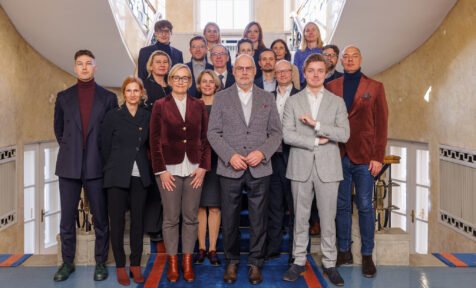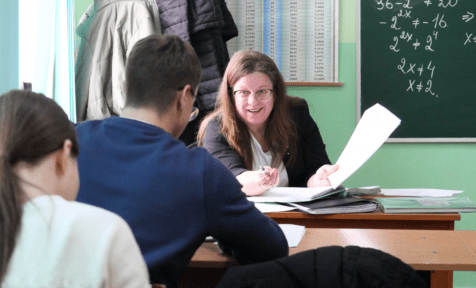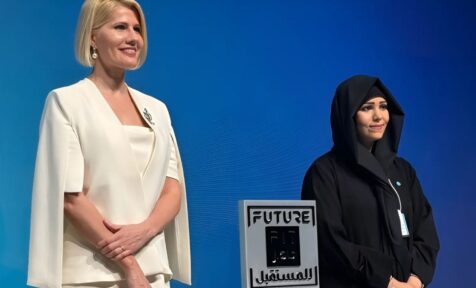It’s been a while now that the world does not seem to be the same anymore. Like everybody else also young people have faced the need to reorient their everyday life. How do young people cope with it and how do they feel about it? I believe these are the key questions to everybody involved in youth work and youth policies. And that is still the „same old“, writes Ülly Enn, then head of smart youth work at Estonian Youth Work Centre.
For more than two decades Estonia has dedicated to develop an evidence-based and engaging contemporary youth policy. In October 2019 Estonia was awarded the Future Policy Award 2019 for youth civic engagement and participation for sustainable development and peace by the World Future Council. The jury noted that the current Estonia’s Youth Field Development Plan presents a comprehensive policy plan aiming to ensure that each young person has ample opportunities for self-development and self-realisation. This award was a continuation of positive recognition of Estonia’s youth policy approach at the international level. In 2018, the OECD’s report “Youth Stocktaking Report” highlighted Estonia as one of the few OECD countries where the trust towards the government is higher among young people compared to older generations. According to the OECD, as one of the reasons, it can be linked to extensive development of youth field as it is in Estonia. Clear vision and strategy are needed to empower young people and support them to gain essential competencies for their own well-being as for their role as active citizens, the report noted. Word. But how do you make sure that no one is left apart, especially in times of social distancing?
Let me confess right away that there has been no magic wand found for that in Estonia. However, there have been quite a few strategic decisions and steps taken to continue support to youth in crisis.
See also:
How sport education in Estonia coped with Covid-19
One of the strengths of Estonian youth field is its diversity as it helps to respond to a wide variety of interests and needs of young people in the age of 7-26 years, as defined in Estonia. During the emergency situation it was considered important on the state level to make sure that the youth field activities would continue. Both the umbrella organisations and state institutions as well as the core field practice – in open youth centres, youth organisations, in hobby activities and hobby education, youth projects and in school youth work etc – have efforted to rapidly adjust their activities and continue to offer young people opportunities for meaningful non-formal learning activities. In 2016, a national Concept for Smart Youth Work has been adopted in Estonia, presenting an innovation concept for youth field with specific emphasis on digital solutions. It has greatly inspired the youth field practice since then and all of these smart youth work solutions have proved to be critically important for quick adaptations now.
With emergency situation being declared, a need for reliable information taking into account the specific needs of young people and professional youth field community was recognised. As one of the first steps, a special web page „For youth field in emergency situation“ was launched by Estonian Youth Work Centre. With official news and instructions from the Ministry of Education and Research, info about webinars, podcasts and other support activities by variety of youth field partners, online resource collection for smart youth work, a call to disseminate good practices etc, this has served as central channel of info and inspiration on state level for youth workers and youth work providers. At the same time, a national youth portal „Teeviit“ (in English „Signpost“) was directed to serve the similar purpose for young people directly, with its special site and with special addition of providing info both in Estonian and in Russian languages during the emergency period. In later weeks the national youth portal has taken initiatives to make the voice of young people more heard through online surveys, challenges etc. F.ex. during the spring school break a youth information campaign was conducted with various partners, incl. Social Insurance Board, Police and Border Guard Board and social media influencers, receiving approx. 320 000 views (over 50 000 views per day) and attracting more than 800 young people with online challenges. As a strategic decision, a team of young volunteers was actively engaged in designing the userfriendly approaches in youth information, considering the specific situation of crisis times.
It would clearly be a mission impossible to try to compile a complete list of all the support activities undertaken by diverse community of youth field partners in Estonia on local and national levels during the emergency period. Hence the following is rather to highlight some of the approaches:
- There are 281 open youth centres in Estonia operating at local level and considered to be the closest low-threshold engagement opportunity for young people. During the corona crisis the physical premises of youth centres were closed, hence many continued as virtual youth centres in digital platforms like Roblox, Discord etc and engaging youth actively with e-sports and in social media. These trends have already brought up a whole list of both potentials and challenges related to new smart approaches: from very positive tendencies to be able to reach out to new young people that prefer virtual youth centres to physical ones; but also issues of risk and safety in digital environments, competences of youth workers in this respect etc.
- The need for mobile youth work and street youth work has increased, also related to the need to avoid youth gatherings in public spaces, to help young people to understand the importance of restrictions as well as to raise their know-how on alternative smart youth work activities. Approaches taken differ by municipalities but alongside with mobile youth work teams there have been some very innovative examples introduced, e.g. using drones connected with audio announcements for youth in public spaces.
- Youth organisations and their umbrella organisations have reoriented to provide sufficient virtual alternatives to their planned physical activities (such as online challenges, webinars etc.). ex Estonian Scout Association teamed up with one of the leading adventure tour organising companies 360° in Estonia and introduced an innovative smart hiking format for their annual spring hike resulting with more than 500 participants taking part both in individual hiking as well as enjoying the virtual camp fire evening in Youtube. Even more interesting, in this e-hiking initiative, there were participants from Estonia up to Australia (!) serving as one of the examples on how the usual limits of physical youth work are overcome with smart solutions. An umbrella organisation Estonian National Youth Council has launched a special web-page with overview of opportunities for virtual participation from different organisations, promoting that these are all open to all young people during the crisis situation, regardless of usual membership limitations.
- In Estonia there is a long tradition of hobby education that is a unique, curricula based non-formal learning service where young people participate voluntarily to benefit from long-term supervised support from professionals in order to develop their competences, be it in music, sport, tech, STEAM or other areas of their interest. It is also one of the most popular activities in youth field in Estonia, with more than half of the overall youth population participating and a vast network of 734 hobby schools all over Estonia. In addition to hobby activities organised in various other formats. During the crisis period also a non-formal learning in hobby activities and hobby education had to be reorganised remotely, e.g. virtual music, dance, arts, sports, robotics and other ICT engagements have been introduced. At the same time, specific concerns are related to private hobby schools that are dependent on tuition fees (534 out of 734 are private hobby schools!). In cases where the organisations were not able to reorient their activities into virtual formats, parents were not able to continue their payments due to economic conditions or preferred not to support other than usual physical formats etc, these organisations were severely faced with risks for cancelling the contracts, moving out of their premises as they are not able to pay rent anymore etc. Hence these organisations are the main target for specific financial aid allocated by the Government of Estonia to ease the negative financial impact of crisis in youth and education field.
- Another field of work that is being considered essential in Estonian youth field to encourage youth participation in diverse formats is youth work in schools. In these critical times, school youth workers continued to support the school youth councils and extra-curricular community activities online to reinforce the support to school democracy and participation. Live discos with up to thousands of students following; online challenges on kendama and other activities popular among youth; Kahoot and other surveys to know how young people are doing in distance learning and what kind of support they would need – these are just some of the examples.
- It appears that there have also been very inspiring examples popping up showing the stronger synergy between formal and non-formal education practices. To further nudge these developments, especially considering the specific situation of remote learning and beyond, a new national portal called NOPIK has been launched by Estonian Youth Work Centre in April.
- Youth field umbrella organisations, incl. Estonian Association of Youth Workers, Association of Estonian Open Youth Centres, Estonian National Youth Council, representation bodies of hobby education etc continued to support their respective communities in youth field via numerous web-meetings, web-counselling etc. The Estonian National Agency of EU programmes of Erasmus+ and European Solidarity Corps has organised virtual trainings and Idea LABs for youth and youth work providers. All these key partners are actively engaged together with the Ministry of Education and Research and Estonian Youth Work Centre to visioning the future perspectives of youth field in relation to current crisis.
Speaking of enhanced cooperation, it goes as well for the common efforts of public and private sectors. With its high number of start-ups per capita, Estonia has a lot of potential in this regard and as an immediate reaction to the need to adopt to remote learning in times of crisis, many start-ups developing educational solutions, like 99math.com, Lingvist.com, Clanbeat.com, Speakly.me, ALPA Kids etc have announced that during the crisis times their products would be available free of charge for organisations in youth and education fields. Both in Estonia and also abroad, for greater community support. As another example, Estonian Youth Work Centre teamed up with Estonian start-up Veriff and other partners and launched a full web-based system for youth workers to apply for occupational standard during the spring application round in 2020 within less than 10 days since the emergency was declared. Also, in beginning of April a Covid-19 thematic hackathon “Hack the Crisis: Youth” was organised by a wide circle of start-up and public sector partners for young people aged 16-19, to empower youth ideas and solutions to tackle the pandemic and its potential impacts. What if we keep this enthusiastic “hands-on & united” approach for co-operation also after the crisis now?
With all of these greatly inspiring examples, it goes without saying that the reorientation to innovative smart formats is greatly dependant on various factors, incl. digital and other resources young people have at their disposal; resources of youth work organisations; innovation and digital competences of youth workers; decisions of institutional management and local municipality levels… These all serve great attention in coming times now in order to minimise potential harm to youth population and avoid further exclusion of young people. In May 2020 Estonia holds the rotating Presidency of the United Nations Security Council and the Permanent Representative of the Republic of Estonia to the United Nations, Ambassador Sven Jürgenson has highlighted that during the current pandemic young people can be among the greatest victims (The New York Times, 27.04.2020). Hence Estonia considers youth work crucially important in the stages of exiting the crisis and also during the post-crisis period.
To conclude, let me pinpoint three ideas I would hope to see as corner stones for future development of youth-centered public policies and services:
- Young people have demonstrated their inspiringly powerful resource to be able to rapidly adopt to changes. Yet, in order to do so, favourable conditions need to be created for youth, especially considering their needs for reliable youth-friendly information, support to mental health and special attention to youth at risk, to name a few. This means that greater attention and efforts are needed from all the adults next to young people, also from youth themselves regarding their peers. To notice, to care and to take action if needed.
- Youth workers have a critically important role in creating trustful relationship and providing meaningful support to young people. For the sake of sustainability of such professional quality support to youth it is important that a diverse variety of youth services would be continued as soon as possible now and financial support to these would be continued despite the challenging economic conditions. Furthermore, intensified attention and measures to support youth work in exiting the crisis as well as during the post-crisis period, incl. local and state level, structural funds etc, needs to be considered.
- Nothing for youth without youth! Sounds good but how? Unfortunately during the crisis times it has not proved to be a too obvious practice to actively engage young people and finding the best possible crisis response solutions based on their contributions. That would need to be reinforced now in different levels and formats, incl. through youth councils in local governments and state institutions, in schools through student representations, in youth work organisations through service design and co-creation. Yet, these are all the formats we already know (and to certain extent already exploit) – what else could be there to have young people have their say in formats that suit them best? And so that no one would be apart?
.





